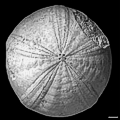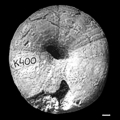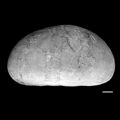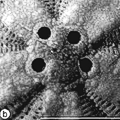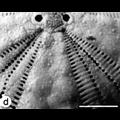The Echinoid Directory
Contributed by Dinesh Srivastava, März 2015
Amblypygus pentagonalis Duncan & Sladen, 1883
[2001 Holectypoid indeterminate genus - Srivastava and Singh, p. 32.
2009 Amblypygus pentagonalis Duncan and Sladen, 1883 - Srivastava, p. 47. ]
| Diagnostic Features |
|
|---|---|
| Distribution | Fulra Limestone Formation, middle Eocene, Kachchh (Gujarat), India. |
| Classification and/or Status | A species of genus Amblypygus. |
| Remarks | A. pentagonalis differs from A. americanus Desor, 1858 in having more steeper anterior and posterior slopes of the test (dome shaped) and by the position of the periproct (Cooke, 1959). The periproct in A. pentagonalis is close to the posterior ambitus whereas, it lies at midway between the posterior ambitus and the peristome in A. americanus. The specimen illustrated here (from Srivastava, 2009) differs from the type specimens in having steeper anterior and posterior slopes and an apical system with oculars 1 and 5 touching each other. Duncan, P. M. & Sladen, W. P., 1883. The fossil Echinoidea of Kutch and Kattywar. Palaeontologia Indica, Ser. 14, 1/4, vi+91 pp. Cooke, C.W. 1959. Cenozoic echinoids of eastern United States. United States Geological Survey Professional Papers 321, iii+106 pp. Srivastava, D. K. & Singh, S. K., 2001. Some species of Amblypygus Agassiz, 1840 and an indeterminate Holectypoid echinoid from the Middle Eocene rocks of Kachchh (=Kutch), India. Journal of Palaeontological Society of India 46, 25-36. Srivastava, D. K., 2009. Taxonomic placement of a holectypoid echinoid genus Srivastava and Singh, 2001. Earth Science India 2/1, 46-51. |
